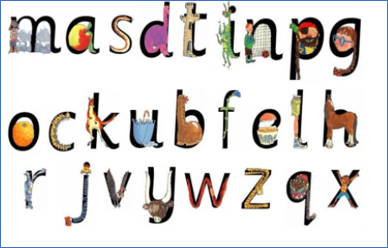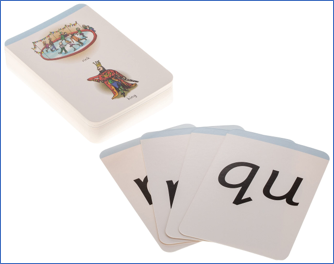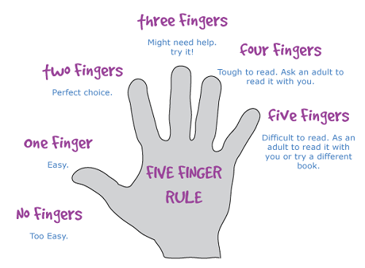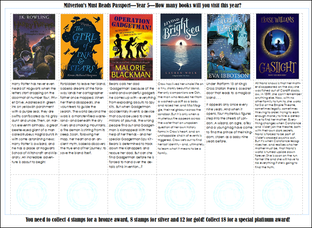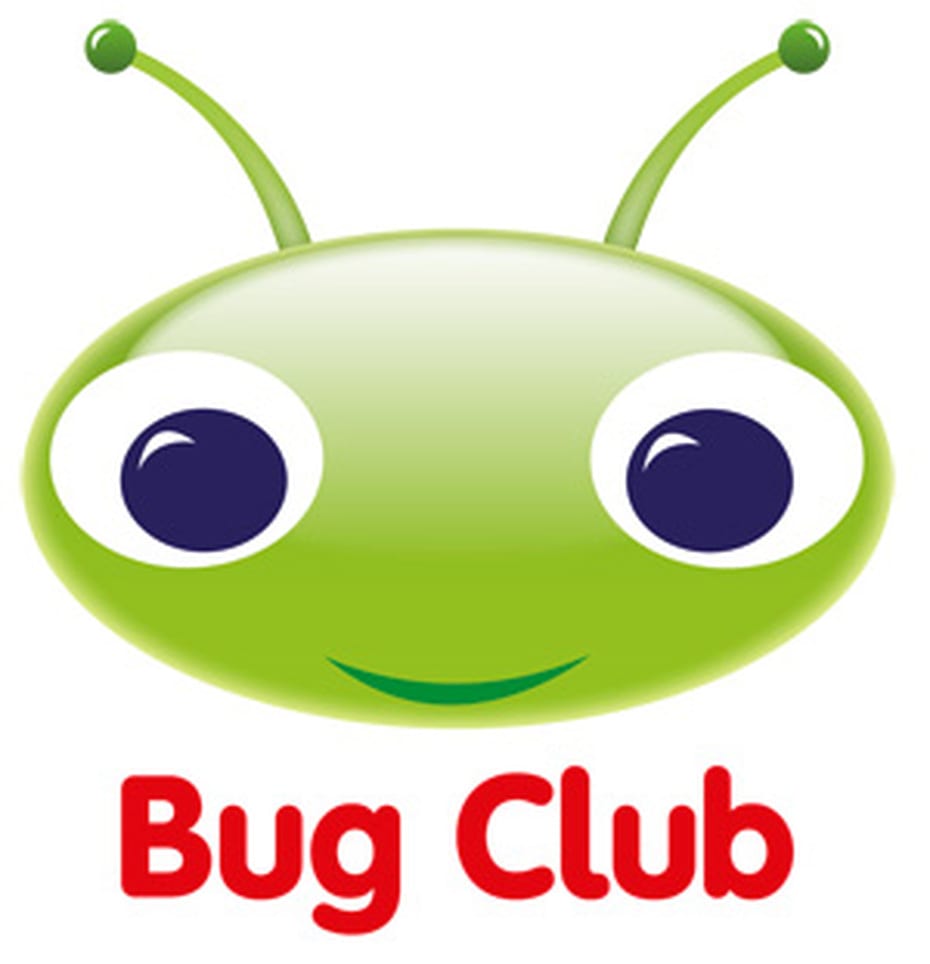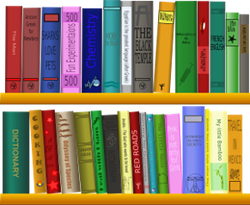
At Milverton we are passionate about teaching children to read and helping to develop their love of reading. Our aims are to ensure all children are able to decode text as soon as possible and to develop their understanding of texts by reading widely and often from a young age.
We greatly value parental partnership when it comes to the children’s learning and one area where your support is vital is developing their ability to read.
The more children practise reading with an adult, the more fluent they become and the more confident they are at answering questions about the books they are reading. Even as children become more independent, this support is still crucial to help them to further develop their comprehension skills.
On this page you will find some key information and advice about how to support your child at home with reading. A much more comprehensive document: ‘Reading at Home: a Parents’ Guide’ is available here. We would recommend reading through this carefully, as it is full of useful tips, advice and ideas. Feel free to speak to a member of staff if you would like any further support.
We greatly value parental partnership when it comes to the children’s learning and one area where your support is vital is developing their ability to read.
The more children practise reading with an adult, the more fluent they become and the more confident they are at answering questions about the books they are reading. Even as children become more independent, this support is still crucial to help them to further develop their comprehension skills.
On this page you will find some key information and advice about how to support your child at home with reading. A much more comprehensive document: ‘Reading at Home: a Parents’ Guide’ is available here. We would recommend reading through this carefully, as it is full of useful tips, advice and ideas. Feel free to speak to a member of staff if you would like any further support.
|
Reading – The Two Key Skills
1. Encoding: Phonics and Word Recognition Phonics is the ability to blend letter sounds (phonemes) together to read words. At Milverton we use Read Write Inc resources for phonics. and demonstrations can be found in the ‘Reading at Home: a Parents’ Guide.’ We have developed a bespoke scheme that uses many of the skills from the Read Write Inc program. Children learn set 1 sounds in reception, blending these sounds together to read and segment words into sounds for spelling. Set 1 sounds are shown in the diagram to the right. We also include: ck, ch, sh, th, ng, nk and qu in Set 1 sounds. Most children will also learn set 2 sounds in reception. These are sounds that comprise of two or three letters, making one sound. Some people describe these as long vowel sounds: ay, ee, igh, ow, oo, oo, ou, oy, ar, or, air ,ir. We aim for reception children to be able to blend these sounds when reading and segment these sounds when spellings words. Children also learn set 3 sounds in year 1. These are the alternative spellings of the set 2 sounds and the less common sounds used in English: ea, oi, a_e, i_e, o_e, u_e, aw, are, ur, er, ow ,ai, oa, ew, ire, ear, ure, tion, cious, tious, e. All children will complete the national phonics screening check in June of Year 1. They are expected to be able to blend words including these Set 3 sounds in order to gain a pass mark. You can buy flashcards and word cards on line to further help your child at home by following the links to the right. More useful tips, advice, information |
Click here to find set 1 flash cards
Click here to find set 2 & 3 flash cards Click here to find green word cards Click here to find red word cards |
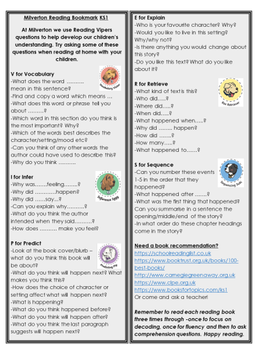
Reading – The Two Key Skills
2. Comprehension – Understanding of Texts
Comprehension is the ability to understand the meaning of the words, sentences, ideas, information and themes in a text.
Your child might sound like a good reader but may not necessarily understand what the text means - being able to read aloud with expression does not mean you understand what you read.
At Milverton, your child will practise his/her reading comprehension skills as part of regular guided reading lessons. The key skills are organised under the following ‘VIPERS’ headings:
Vocabulary
Inference
Prediction
Explanation
Retrieval
Sequencing (KS1) Summarising (KS2)
To further support your child with these skills, we provide a reading bookmark within the termly home learning packs, which includes questions linked to each one.
An example of the reading bookmark can be viewed above and all phases can be found within the Parents’ Guide.
2. Comprehension – Understanding of Texts
Comprehension is the ability to understand the meaning of the words, sentences, ideas, information and themes in a text.
Your child might sound like a good reader but may not necessarily understand what the text means - being able to read aloud with expression does not mean you understand what you read.
At Milverton, your child will practise his/her reading comprehension skills as part of regular guided reading lessons. The key skills are organised under the following ‘VIPERS’ headings:
Vocabulary
Inference
Prediction
Explanation
Retrieval
Sequencing (KS1) Summarising (KS2)
To further support your child with these skills, we provide a reading bookmark within the termly home learning packs, which includes questions linked to each one.
An example of the reading bookmark can be viewed above and all phases can be found within the Parents’ Guide.
|
Reading Books
In EYFS and KS1, your child will have his/her home reading book changed weekly, following a structured reading scheme and they will also be allowed to choose a book from the school library. We would recommend reading each book at least twice – firstly to focus on fluency and the second time round to check for comprehension by asking questions using the reading bookmarks printed within the home learning packs. In KS2, once the children have moved beyond the structured reading scheme, they will choose a free reading library book following the five finger rule. We also encourage you always to supplement your child’s reading book with books from home and/or the library in Leamington, so they experience a broad range of authors and text types. Use the space provided in your child’s home learning pack to record how many minutes he/she has read each week and help his/her class win the reading trophy. The class that wins the most in a term will receive £50 to spend on new books! To further supplement your child’s reading experience, he/she will be given a login for Bugclub Online. This is a great online resource, which allows children to earn rewards each time they read and answer the accompanying questions. Additionally, all children are given a Milverton’s Must Reads passport containing 18 recommended reads for their year group. You can help your child to achieve his/her bronze, silver, gold and even platinum reading award by reading as many books from the passport as possible. There is also a range of excellent websites, where age-appropriate book recommendations can be found. Here is a selection: https://schoolreadinglist.co.uk https://www.booktrust.org.uk http://www.carnegiegreenaway.org. https://www.clpe.org.uk https://booksfortopics.com |
Reading Videos
With the help of some very brave pupils (and teachers!) we have put together some videos showing what a home reading session might look like in different year groups.
We would recommend broadly following the structure outlined below, but first and foremost, have fun reading together!
1. INTRODUCE THE BOOK/RECAP THE STORY SO FAR
2. READING TOGETHER (PHONICS & WORD RECOGNITION)
3. COMPREHENSION QUESTIONS USING THE READING BOOKMARK
4. SUMMARISING/EVALUATING/PREDICTING WHAT MIGHT HAPPEN NEXT
With the help of some very brave pupils (and teachers!) we have put together some videos showing what a home reading session might look like in different year groups.
We would recommend broadly following the structure outlined below, but first and foremost, have fun reading together!
1. INTRODUCE THE BOOK/RECAP THE STORY SO FAR
2. READING TOGETHER (PHONICS & WORD RECOGNITION)
3. COMPREHENSION QUESTIONS USING THE READING BOOKMARK
4. SUMMARISING/EVALUATING/PREDICTING WHAT MIGHT HAPPEN NEXT
|
|
|
End of Key Stage Assessments
At the end of years 2 and 6, children will sit SATs (Standard Assessment Tests) in reading.
They will be expected to independently read a collection of fiction and non fiction texts and answer questions about them.
Within the ‘Reading at Home: a Parents’ Guide,’ you can find example questions for years 2 and 6 and past papers can be found here: https://www.satspapers.org.uk/
Final Thoughts
Children who read regularly will have a much wider vocabulary than those that don’t. Research shows how much regular reading to a child, even before they start school, affects their understanding of words:
A children who is…
*never read to will have heard 4662 words
*read to 1-2 times per week will have heard 63 570 words
*read to 3-5 times per week will have heard 169 520 words
*read to daily will have heard 296 660 words
The simple truth is, the more a child reads and is read to, the more vocabulary they will learn – this will greatly impact their ability to succeed in other areas across the curriculum. Reading for 20 minutes each day exposes children to around 2 million words per year and evidence suggests that children who read for enjoyment every day not only perform better in reading tests than those who don’t, but also develop a broader vocabulary, increased general knowledge and a better understanding of other cultures (Pearson).
First and foremost though, reading is fun! We hope you enjoy reading together.
At the end of years 2 and 6, children will sit SATs (Standard Assessment Tests) in reading.
They will be expected to independently read a collection of fiction and non fiction texts and answer questions about them.
Within the ‘Reading at Home: a Parents’ Guide,’ you can find example questions for years 2 and 6 and past papers can be found here: https://www.satspapers.org.uk/
Final Thoughts
Children who read regularly will have a much wider vocabulary than those that don’t. Research shows how much regular reading to a child, even before they start school, affects their understanding of words:
A children who is…
*never read to will have heard 4662 words
*read to 1-2 times per week will have heard 63 570 words
*read to 3-5 times per week will have heard 169 520 words
*read to daily will have heard 296 660 words
The simple truth is, the more a child reads and is read to, the more vocabulary they will learn – this will greatly impact their ability to succeed in other areas across the curriculum. Reading for 20 minutes each day exposes children to around 2 million words per year and evidence suggests that children who read for enjoyment every day not only perform better in reading tests than those who don’t, but also develop a broader vocabulary, increased general knowledge and a better understanding of other cultures (Pearson).
First and foremost though, reading is fun! We hope you enjoy reading together.
